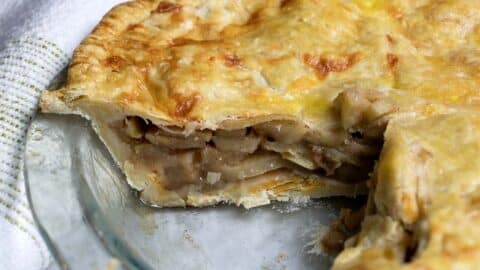Cheddar Apple Pie
Enjoying apple pie with cheddar cheese is tradition, and this recipe combines a buttery cheddar crust with a gooey, perfectly sweet apple filling for the perfect Cheddar Apple Pie.
Equipment
- 1 9 inch pie tin
Ingredients
For the Cheddar Crust
- 2½ cups all purpose flour
- 1 tbsp granulated sugar
- 1 tsp salt
- 1 cup unsalted butter chilled and cut into small cubes
- ½ cup cold water
- 1 cup freshly shredded sharp cheddar cheese
- 1 egg
- 1 tbsp milk
For the Filling
- 8 large Granny Smith apples cored, peeled, and cut into slices
- ½ cup granulated sugar
- 2 tbsp lemon juice
- 1½ tsp apple pie spice
- ½ tsp cinnamon
- ¼ cup water
- 2 tbsp cornstarch
- 2 tbsp water
Recipe Instructions
Cheddar Crust
- Place ice cube in ½ cup water to ensure it's very cold. Let melt while you prepare the crust.
- In a large bowl, mix the flour, sugar and salt. Add the cubed butter. Use a pastry cutter or your hands to cut the butter into the dry ingredients. You want pea-sized pieces of butter coated in flour, but it's ok if there are some large bits.
- Take your ~ ½ cup of cold water and drizzle 2 tbsp into the flour mixture at a time, stirring after each drizzle. Stop adding water when large clumps begin to form (it should be moist, but not overly wet). Then, use a spatula to fold in the cheese. Try not to overwork the dough.
- On a lightly floured surface, fold the dough into itself a few times until the fats are incorporated.
- Form into a ball and cut in half. Using your hands, form each half into a 1 inch thick flat disk. Wrap tightly in plastic wrap and refrigerate for 2 hours or up to 2 days.
The Filling
- Peel, core, and cut the apple into thin slices or chunks (whichever you prefer). Place them in a large bowl. Sprinkle with the granulated sugar and lemon juice. Toss to coat and set aside.
- In a large pan over medium heat, add your butter, brown sugar, salt, apple pie spice mix, and ¼ cup of water. Stir frequently and bring to a low simmer.
- Dump in the apples, including any liquid from the bowl. Stir to coat the apples in the butter mixture. Cook, stirring occasionally for 5 minutes until slightly softened and fragrant.
- Meanwhile, mix together 2 tbsp of water and 2 tbsp of cornstarch in a small bowl. Add to the pan and stir to combine. Bring to a light boil and cook for another minute to thicken.
- Remove from the heat and allow to cool. The filling can be made several days ahead of time.
Assembly
- Start by flouring your work surface, then take one of the discs of chilled dough out (keep the other in the fridge for now). As you roll it out, give the dough a quarter turn every few rolls until you have a nice circle about 12 inches wide. If you spot any cracks at the edges, smooth them out gently with your fingers. Keeping your work surface, rolling pin, and hands lightly dusted with flour will make this process smoother.
- Now, carefully transfer the dough into a 9-inch pie dish, tucking it in neatly with your fingers for a smooth finish. If you'd like a thicker edge, I usually leave the excess dough around the edges instead of trimming it. Just fold that extra dough back over the edge and shape it into a nice thick rim—this can be done either before or after adding the top crust.
- Add the filling into the crust.
- Roll out the second pie crust just like you did with the bottom one. You have a couple of options here: you can simply place the crust over the filling for a classic double crust pie (make sure to cut a few slits in the top for ventilation) or get creative with a beautiful pie crust design, like a lattice or braided pattern. For the edges, you can crimp them with a fork or use your fingers to flute them.
- To finish, brush the crust with an egg wash and, if you like, sprinkle some coarse sugar on top to add a delightful sweet crunch.
- Preheat oven to 400℉. While it's heating, place your pie in the refrigerator. The colder the pie, the better it holds up its shape.
- Bake for 20 minutes (with a baking sheet under it in case it bubbles over). At this point, add a pie crust shield or tin foil to protect the crust from burning. Lower the temp to 375℉, return to the oven, and bake for 35 more minutes.
- Cool for at least 2 hours before serving to allow the filling to thicken up.
Nutrition
Calories: 3349kcalCarbohydrates: 371gProtein: 41gFat: 193gSaturated Fat: 119gPolyunsaturated Fat: 9gMonounsaturated Fat: 50gTrans Fat: 7gCholesterol: 654mgSodium: 2434mgPotassium: 530mgFiber: 10gSugar: 115gVitamin A: 5947IUVitamin C: 12mgCalcium: 182mgIron: 16mg
Tried this recipe?Mention @thembitesrecipes or tag #thembites
